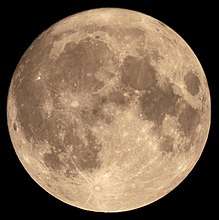Full moon
The full moon is the lunar phase when the Moon appears fully illuminated from Earth's perspective. This occurs when Earth is located between the Sun and the Moon (more exactly, when the ecliptic longitudes of the Sun and Moon differ by 180°).[3] This means that the lunar hemisphere facing Earth – the near side – is completely sunlit and appears as a circular disk. The full moon occurs roughly once a month.

The time interval between a full (or new) moon and the next repetition of the same phase, a synodic month, averages about 29.53 days. Therefore, in those lunar calendars in which each month begins on the day of the new moon, the full moon falls on either the 14th or 15th day of the lunar month. Because a calendar month consists of a whole number of days, a month in a lunar calendar may be either 29 or 30 days long.
Characteristics
A full moon is often thought of as an event of a full night's duration. This is somewhat misleading because its phase seen from Earth continuously waxes or wanes (though much too slowly to notice in real time with the naked eye). By definition, its maximum illumination occurs at the moment waxing stops. For any given location, about half of these maximum full moons may be visible, while the other half occurs during the day, when the full moon is below the horizon.
Many almanacs list full moons not only by date, but also by their exact time, usually in Coordinated Universal Time (UTC). Typical monthly calendars that include lunar phases may be offset by one day when prepared for a different time zone.
The full moon is generally a suboptimal time for astronomical observation of the Moon because shadows vanish. It is a poor time for other observations because the bright sunlight reflected by the Moon, amplified by the opposition surge, then outshines many stars.
On 12 December 2008, the full moon was closer to the Earth than it had been at any time in the previous 15 years. This was referred to in popular media as a supermoon.[4]
On 19 March 2011, there was another full "supermoon", closer to the Earth than at any time in the previous 18 years.[5]
On 14 November 2016, there was another full "supermoon"; this time it was closer to the Earth than at any time in the previous 68 years.[6]
Formula
The date and approximate time of a specific full moon (assuming a circular orbit) can be calculated from the following equation:[7]
where d is the number of days since 1 January 2000 00:00:00 in the Terrestrial Time scale used in astronomical ephemerides; for Universal Time (UT) add the following approximate correction to d:
- days
where N is the number of full moons since the first full moon of 2000. The true time of a full moon may differ from this approximation by up to about 14.5 hours as a result of the non-circularity of the Moon's orbit.[8] See New moon for an explanation of the formula and its parameters.
The age and apparent size of the full moon vary in a cycle of just under 14 synodic months, which has been referred to as a full moon cycle.
Lunar eclipses
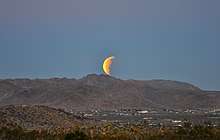
When the Moon moves into Earth's shadow, a lunar eclipse occurs, during which all or part of the Moon's face may appear reddish due to the Rayleigh scattering of blue wavelengths and the refraction of sunlight through Earth's atmosphere.[9][10][11] Lunar eclipses happen only during a full moon and around points on its orbit where the satellite may pass through the planet's shadow. A lunar eclipse does not occur every month because the Moon's orbit is inclined 5.14° with respect to the ecliptic plane of Earth; thus, the Moon usually passes north or south of Earth's shadow, which is mostly restricted to this plane of reference. Lunar eclipses happen only when the full moon occurs around either node of its orbit (ascending or descending). Therefore, a lunar eclipse occurs about every six months, and often two weeks before or after a solar eclipse, which occurs during a new moon around the opposite node.
In folklore and tradition
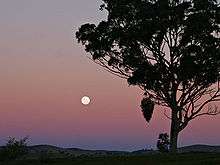
Full moons are traditionally associated with insomnia (inability to sleep), insanity (hence the terms lunacy and lunatic) and various "magical phenomena" such as lycanthropy. Psychologists, however, have found that there is no strong evidence for effects on human behavior around the time of a full moon.[12] They find that studies are generally not consistent, with some showing a positive effect and others showing a negative effect. In one instance, the 23 December 2000 issue of the British Medical Journal published two studies on dog bite admission to hospitals in England and Australia. The study of the Bradford Royal Infirmary found that dog bites were twice as common during a full moon, whereas the study conducted by the public hospitals in Australia found that they were less likely.
Full moon names
Historically, month names are names of moons (lunations, not necessarily full moons) in lunisolar calendars. Since the introduction of the solar Julian calendar in the Roman Empire, and later the Gregorian calendar worldwide, people no longer perceive month names as "moon" names. The traditional Old English month names were equated with the names of the Julian calendar from an early time (soon after Christianization, according to the testimony of Bede around AD 700).
Some full moons have developed new names in modern times, such as "blue moon", as well as "harvest moon" and "hunter's moon" for the full moons of autumn.
Lunar eclipses occur only at a full moon and often cause a reddish hue on the near side of the Moon. This full moon has been called a blood moon in popular culture.[13]
Harvest and hunter's moons
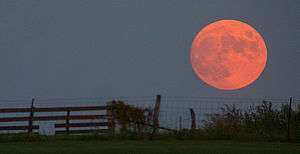
The "harvest moon" and the "hunter's moon" are traditional names for the full moons in late summer and in the autumn in the Northern Hemisphere, usually in September and October, respectively.
The "harvest moon" is the full moon nearest to the autumnal equinox (22 or 23 September), occurring anytime within two weeks before or after that date.[15] The "hunter's moon" is the full moon following it. The names are recorded from the early 18th century.[16] The Oxford English Dictionary entry for "harvest moon" cites a 1706 reference, and for "hunter's moon" a 1710 edition of The British Apollo, where the term is attributed to "the country people" ("The Country People call this the Hunters-Moon.") The names became traditional in American folklore, where they are now often popularly attributed to Native Americans.[17] The Feast of the Hunters' Moon is a yearly festival in West Lafayette, Indiana, held in late September or early October each year since 1968.[18] In 2010, the harvest moon occurred on the night of the equinox itself (some 51⁄2 hours after the moment of equinox) for the first time since 1991.[19][20]
All full moons rise around the time of sunset. Since the Moon moves eastward among the stars faster than the Sun, lunar culmination is delayed by about 50.47 minutes[21] (on average) each day, thus causing moonrise to occur later each day.
Due to the high lunar standstill, the harvest and hunter's moons of 2007 were special because the time difference between moonrises on successive evenings was much shorter than average. The Moon rose about 30 minutes later from one night to the next, as seen from about 40° N or S latitude (because the full moon of September 2007 rose in the northeast rather than in the east). Hence, no long period of darkness occurred between sunset and moonrise for several days after the full moon,[22] thus lengthening the time in the evening when there is enough twilight and moonlight to work to get the harvest in.
Farmers' Almanacs
The Maine Farmers' Almanac from around the 1930s began to publish Native American "Indian" full moon names. The Farmers' Almanac (since 1955 published in Maine, but not the same publication as the Maine Farmers' Almanac) continues to do so.[23]
An early list of "Indian month names" was published in 1918 by Daniel Carter Beard in his The American Boy's Book of Signs, Signals and Symbols for use by the boy scouts. Beard's "Indian" month names were:[24]
- January: Difficulty, Black Smoke
- February: Raccoon, Bare Spots on the Ground
- March: Wind, Little Grass, Sore-Eye
- April: Ducks, Goose-Eggs
- May: Green Grass, Root-Food
- June: Corn-Planting, Strawberry
- July: Buffalo (Bull), Hot Sun
- August: Harvest, Cow Buffalo
- September: Wild Rice, Red Plum
- October: Leaf-Falling, Nuts
- November: Deer-Mating, Fur-Pelts
- December: Wolves, Big Moon
Such names have gained currency in American folklore. They appear in print more widely outside of the almanac tradition from the 1990s in popular publications about the Moon. Mysteries of the Moon by Patricia Haddock ("Great Mysteries Series", Greenhaven Press, 1992) gave an extensive list of such names along with the individual tribal groups they were supposedly associated with.[25] Haddock supposes that certain "Colonial American" moon names were adopted from Algonquian languages (which were formerly spoken in the territory of New England), while others are based in European tradition (e.g. the Colonial American names for the May moon, "Milk Moon", "Mother's Moon", "Hare Moon" have no parallels in the supposed native names, while the name of November, "Beaver Moon" is supposedly based in an Algonquian language).
The individual names (some inconsistent) given in Farmers' Almanac, which is not authoritative, include the following:
- January: "Wolf Moon" (for December in Beard 1918),[26] "Old Moon", "Moon After Yule", "Winter Moon"
- February: "Snow Moon", "Hunger Moon", "Storm Moon"
- March: "Worm Moon", "Crow Moon", "Sap Moon", "Crust Moon", "Lenten Moon", "Wind Moon"
- April: "Seed Moon", "Pink Moon", "Sprouting Grass Moon", "Pascal Moon", "Egg Moon" (c.f. "Goose-Egg" in Beard 1918), "Fish Moon", "Frog Moon", "Spring Moon", "Awakening Moon", "Sap Moon"
- May: "Milk Moon", "Flower Moon", "Corn Planting Moon", "Grass Moon", "Mother's Moon"
- June: "Mead Moon", "Strawberry Moon" (c.f. Beard 1918), "Rose Moon", "Hot Moon", "Thunder Moon"
- July: "Hay Moon", "Buck Moon", "Elk Moon", "Summer Moon", "Thunder Moon"
- August: "Corn Moon", "Sturgeon Moon", "Red Moon", "Barley Moon", "Green Corn Moon", "Grain Moon", "Herb Moon", "Wyrt Moon", "Dog Moon"
- September: "Harvest Moon", "Corn Moon", "Fruit Moon", "Barley Moon"
- October: "Hunter's Moon", "Blood Moon", "Autumn Moon", "Fall Moon", "Sanguine Moon", "Pumpkin Moon", "Dying Moon"
- November: "Beaver Moon", "Turkey Moon", "Frosty Moon", "Dark Moon"
- December: "Oak Moon", "Cold Moon", "Long Night's Moon"
The Long Night's Moon is the last full moon of the year and the one nearest the winter solstice.[27]
"Ice Moon" is also used to refer to the first full moon of January or February.[28]
Hindu full moon festivals
In Hinduism, most festivals are celebrated on auspicious days. Many of the Hindu festivals are celebrated on days with a full moon at night. Different parts of India celebrate the same day with different names, as listed below:
- Chaitra Purnima – Gudi Padua, Yugadi, Ugadi, Hanuman Jayanti (April 15, 2014)[29]
- Vaishakh Purnima – Narasimh Jayanti, Buddha Jayanthi (Buddha's_Birthday) (May 14, 2014)[30]
- Jyeshtha Purnima – Vat Savitri Vrat Vat Purnima (June 8, 2014)[31]
- Ashadh Purnima – Guru Purnima, Vyas Purnima (important day for starting education and honoring teachers[31])
- Shravan Purnima – Good day for starting Upanayana day, Avani Avittam, Raksha Bandhan. Conceptually Onam also comes on this day.
- Bhadrapad Purnima – Start of Pitru Paksha, Madhu Purnima
- Ashvin Purnima – Sharad Purnima
- Kartik Poornima – Karthikai Deepam festival, Thrukkarthika (in Kerala)
- Margasirsha Purnima – Thiruvathira, Dathatreya Jayanthi
- Pushya Purnima – Thaipusam, Shakambharee Purnima
- Magha Purnima
- Phalguna Purnima – Holi
Lunar and lunisolar calendars
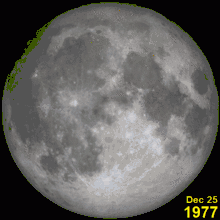
Most pre-modern calendars the world over were lunisolar, combining the solar year with the lunation by means of intercalary months.[34][35] The Julian calendar abandoned this method in favour of a purely solar reckoning while conversely the 7th-century Islamic calendar opted for a purely lunar one.
A continuing lunisolar calendar is the Hebrew calendar. Evidence of this is noted in the dates of Passover and Easter in Judaism and Christianity, respectively. Passover falls on the full moon on 15 Nisan of the Hebrew calendar. The date of the Jewish Rosh Hashana and Sukkot festivals along with all other Jewish holidays are dependent on the dates of the new moons.[36]
Intercalary months
In lunisolar calendars, an intercalary month occurs seven times in the 19 years of the Metonic cycle, or on average every 2.7 years (19/7). In the Hebrew Calendar this is noted with a periodic extra month of Adar in the early spring.
Blue moon
In the modern system of "traditional" American full moon names tied to the solstice and equinox points, a supernumerary full moon in such a period is called a blue moon. The term "blue moon" used in this sense may date to as early as the 16th century, but it became well-known in the United States due to the Farmers' Almanac (published since 1818).[38]
According to the pattern of use in the Farmers' Almanac, a "blue moon" is the third full moon in any period between either a solstice and an equinox, or between an equinox and a solstice, (calculated using the mean tropical year), which contains four full moons.[39] These seasons are equal in length, unlike the astronomical ones, which vary in length depending on the Earth's speed in its elliptical orbit round the Sun. To compare, in 1983 the equal length seasons began at 1:48 am on 23 March, 9:15 am on 22 June, 4:42 pm on 21 September and 12:10 am on 22 December, while the astronomical seasons began at 4:39 am on 21 March, 11:09 pm on 21 June, 2:42 pm on 23 September and 10:30 am on 22 December (all times GMT).
Due to analysis of an inadequate number of old issues of the Farmer's Almanac the author of an article in the March 1946 issue of Sky & Telescope magazine falsely concluded that a "blue moon" had been used in the sense of "the second full moon in any month which contains two full moons". This mistaken rule has been admitted to be "erroneous" in a 1999 Sky & Telescope article, which gave the corrected rule based on order in seasons.[40] According to either definition, "blue moons" occur with the average frequency of intercalary months, seven times in 19 years, the Farmers' Almanac system of full moon names effectively defining a lunisolar calendar.
References
- "'Super Moon' ExceptIonal Brightest Moon in the Sky of Normandy, Monday, November 14". silvertimes.com. 2016-11-12. Retrieved 2017-02-08.
- "Moongazers Delight — Biggest Supermoon in Decades Looms Large Sunday Night". 10 November 2016.
- [P. Kenneth Seidelmann (ed.), [https://archive.org/details/131123ExplanatorySupplementAstronomicalAlmanac/page/n253 "Phases of the Moon"], Explanatory Supplement to the Astronomical Almanac: A Revision to the Explanatory Supplement to the Astronomical Ephemeris and the American Ephemeris and Nautical Almanac, (Mill Valley: University Science Books, 1992), p. 478.
- Phillips, Tony (9 December 2008). "Biggest Full Moon of the Year". Science@NASA. Archived from the original on 9 March 2010. Retrieved 4 March 2010.
- Phillips, Tony (16 March 2011). "Super Full Moon". Science@NASA. Archived from the original on 7 May 2012. Retrieved 13 March 2014.
- Phillips, Tony (14 October 2016). "Super Full Moon". Science@NASA. Retrieved 13 November 2016.
- Meeus, Jean (1998). "Phases of the Moon". Astronomical Algorithms (2nd ed.). Richmond, Virginia: Willmann-Bell. pp. 349–354. ISBN 0-943396-61-1.
- Meeus, Jean (2002). "The Duration of the Lunation". More Mathematical Astronomy Morsels. Richmond, Virginia: Willmann-Bell. pp. 19–31. ISBN 0-943396-74-3.
- Seidelmann, P. Kenneth (2005). "Phases of the Moon". Explanatory Supplement to the Astronomical Almanac. University Science Books. p. 478. ISBN 0-935702-68-7.
They are the times when the excess of the Moon's apparent geocentric ecliptic longitude λM over the Sun's apparent geocentric ecliptic longitude is 0, 90, 180, or 270 ...
- "Celestial Alignment without Lunar Eclipse; from google (full moon earth block sunlight) result 2".
- "tilted from the ecliptic by about 5 degrees; from google (full moon earth block sunlight) result 3". Archived from the original on 2017-06-28. Retrieved 2016-09-19.
- "Full Moon Effect On Behavior Minimal, Studies Say". National Geographic News. 6 February 2004.
- Sappenfield, Mark (13 April 2014). "Blood Moon to arrive Monday night. What is a Blood Moon?". Christian Science Monitor. Retrieved 8 February 2018.
- Percy, John (27 September 2010). "Why is the harvest moon so big and orange?". University of Toronto. Archived from the original on 3 March 2016. Retrieved 9 January 2015.
- "What is a Harvest Moon?". Old Farmer's Almanac.
- Ferguson, James (1756). Astronomy explained upon Sir Isaac Newton's principles, and made easy to those who have not studied mathematics. p. 128.
...'harvest moon' is also the cognate of herbist-mānod, the Old High German name of November recorded in Vita Karoli Magni, ch. 29.
- Neata, Emil. "The Hunter's Moon". Night Sky Info. Retrieved 29 December 2008.
- "Feast of the Hunters' Moon". Tippecanoe County Historical Association. Archived from the original on 2009-06-20.
- Phillips, Tony (22 September 2010). "Watch out for the Super Harvest Moon". NASA Science. Retrieved 13 September 2011.
- Maddox, Jack (22 September 2010). "Super Harvest Moon: Autumn phenomenon is a rare treat". CNN. Archived from the original on 18 July 2011. Retrieved 13 September 2011.
- 1440 minutes / 29.531 days = 50.47 minutes
- McNish, Larry (2007). "Sunset and Moonrise". RASC Calgary Centre.
This gives a graph showing the effect as seen from Calgary, for the whole of the year 2007.
- "Full Moon Names and Their Meanings". Farmers' Almanac. Archived from the original on 2007-10-05.CS1 maint: BOT: original-url status unknown (link) (); "Full Moons: What's in a Name?". National Geographic. Retrieved 12 January 2012.
- Beard 1918, pp. 78–80. "The Indians' Moons naturally vary in the different parts of the country, but by comparing them all and striking an average as near as may be, the moons are reduced to the following"
- repeated in The Moon Book by Kim Long (1998:102ff.) Also in Llewellyn's 1996 Moon Sign Book (1995)
- "Wolf Moon" is attributed to Algonquian by Haddock (1992); the actual Algonquian name for that moon is squochee kesos or "sun has not strength to thaw". The New England historical & genealogical register and antiquarian journal: v. 10 The Sioux do mention wolves in their name for January, which means "when wolves run together". American Indian Moons; they also refer to that moon as the "moon of the strong cold" or "frost in the teepee". Other tribes had different names for the moons. See also Indian Moons, Days & Other Calendar Stuff American Indian Moons
- Dance, Scott (December 23, 2015). "'Long Night's Moon' comes on Christmas for first time since 1977". Baltimore Sun.
- "Wolf Moon is the Full Moon in January".
- "2014 Chaitra Purnima | Chaitra Pournami date for Amsterdam, North Holland, Netherlands".
- "2014 Vaishakha Purnima | Vaishakha Pournami date for Amsterdam, North Holland, Netherlands".
- "2014 Guru Purnima | Vyasa Purnima Puja Date and Time for Amsterdam, North Holland, Netherlands".
- Rare Full Moon on Christmas Day, NASA
- Ask Tom: How unusual is a full moon on Christmas Day?
- see e.g., Blackburn, Bonnie; et al. (1999). The Oxford Companion to the Year. Oxford University Press. ISBN 0-19-214231-3.
- Reingold, Edward M.; et al. (2001). Calendrical Calculations: The Millennium Edition. Cambridge University Press. ISBN 0-521-77752-6.
- Leviticus 23:4–7, 33–35.
- Wolsey, Thomas. "Rede me and be nott wrothe, for I say no thynge but trothe" (1871 ed.). p. 114.; it isn't clear however if this refers to intercalation.
- The saying "once in a blue moon" meaning "very rarely" is recorded since the 1820s. The term "blue moon" is recorded in 1528, in the couplet O churche men are wyly foxes [...] Yf they say the mone is blewe / We must beleve that it is true / Admittynge their interpretacion.[37]
- "What is a blue moon?". Farmers' Almanac. 24 August 2009. Archived from the original on 24 January 2018.
- "What's a blue moon?". Sky and Telescope. Archived from the original on 27 March 2014. Retrieved 7 October 2009.
External links
| Wikimedia Commons has media related to Full moon. |
